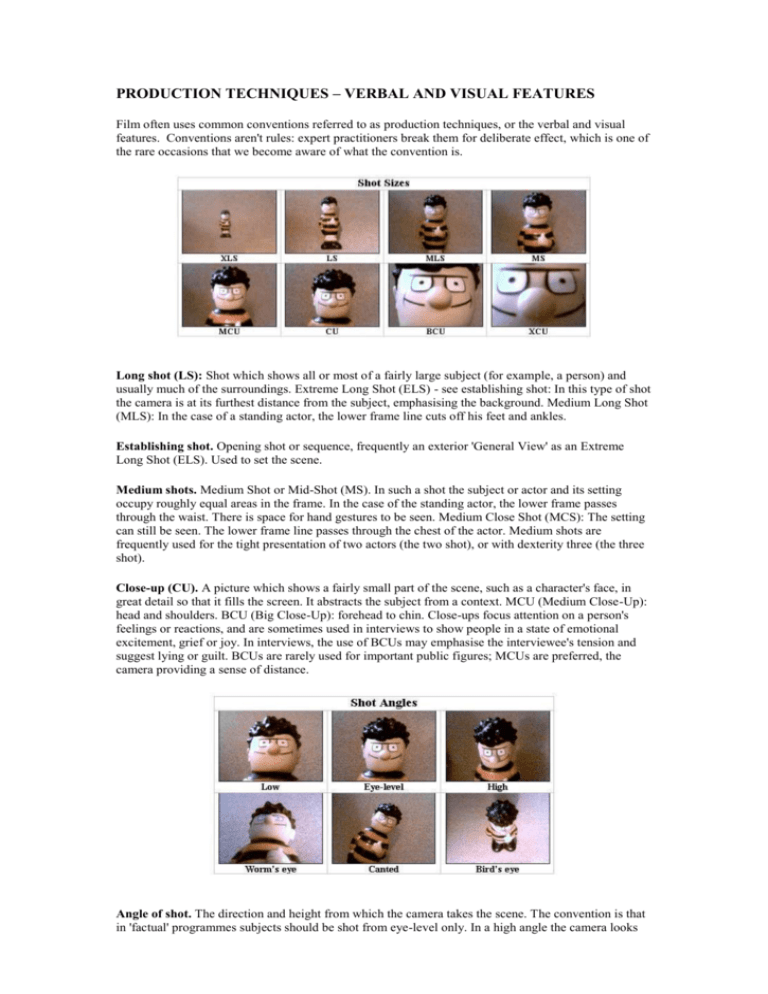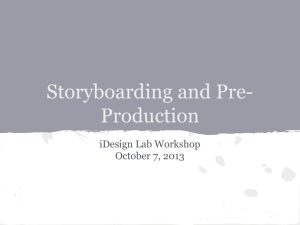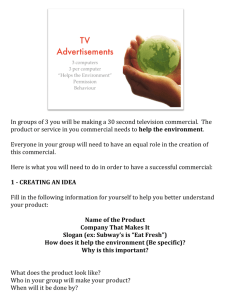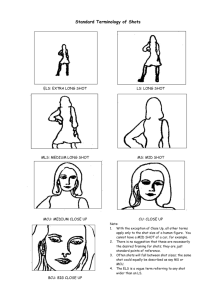production techniques – verbal and visual features
advertisement

PRODUCTION TECHNIQUES – VERBAL AND VISUAL FEATURES Film often uses common conventions referred to as production techniques, or the verbal and visual features. Conventions aren't rules: expert practitioners break them for deliberate effect, which is one of the rare occasions that we become aware of what the convention is. Long shot (LS): Shot which shows all or most of a fairly large subject (for example, a person) and usually much of the surroundings. Extreme Long Shot (ELS) - see establishing shot: In this type of shot the camera is at its furthest distance from the subject, emphasising the background. Medium Long Shot (MLS): In the case of a standing actor, the lower frame line cuts off his feet and ankles. Establishing shot. Opening shot or sequence, frequently an exterior 'General View' as an Extreme Long Shot (ELS). Used to set the scene. Medium shots. Medium Shot or Mid-Shot (MS). In such a shot the subject or actor and its setting occupy roughly equal areas in the frame. In the case of the standing actor, the lower frame passes through the waist. There is space for hand gestures to be seen. Medium Close Shot (MCS): The setting can still be seen. The lower frame line passes through the chest of the actor. Medium shots are frequently used for the tight presentation of two actors (the two shot), or with dexterity three (the three shot). Close-up (CU). A picture which shows a fairly small part of the scene, such as a character's face, in great detail so that it fills the screen. It abstracts the subject from a context. MCU (Medium Close-Up): head and shoulders. BCU (Big Close-Up): forehead to chin. Close-ups focus attention on a person's feelings or reactions, and are sometimes used in interviews to show people in a state of emotional excitement, grief or joy. In interviews, the use of BCUs may emphasise the interviewee's tension and suggest lying or guilt. BCUs are rarely used for important public figures; MCUs are preferred, the camera providing a sense of distance. Angle of shot. The direction and height from which the camera takes the scene. The convention is that in 'factual' programmes subjects should be shot from eye-level only. In a high angle the camera looks down at a character, making the viewer feel more powerful than him or her, or suggesting an air of detachment. A low angle shot places camera below the character, exaggerating his or her importance. An overhead shot is one made from a position directly above the action. Viewpoint. The apparent distance and angle from which the camera views and records the subject. Not to be confused with point-of-view shots or subjective camera shots. Point-of-view shot (POV). A shot made from a camera position close to the line of sight of a performer who is to be watching the action shown in the point-of-view shot. Soft focus. An effect in which the sharpness of an image, or part of it, is reduced by the use of an optical device. Wide-angle shot. A shot of a broad field of action taken with a wide-angle lens. Tilted shot. When the camera is tilted on its axis so that normally vertical lines appear slanted to the left or right, ordinary expectations are frustrated. Such shots are often used in mystery and suspense films to create a sense of unease in the viewer. Zoom. In zooming in the camera does not move; the lens is focussed down from a long-shot to a closeup whilst the picture is still being shown. The subject is magnified, and attention is concentrated on details previously invisible as the shot tightens (contrast tracking). It may be used to surprise the viewer. Zooming out reveals more of the scene (perhaps where a character is, or to whom he or she is speaking) as the shot widens. Zooming in rapidly brings not only the subject but also the background hurtling towards the viewer, which can be disconcerting. Zooming in and then out creates an ugly 'yoyo' effect. Pan. The camera swivels (in the same base position) to follow a moving subject. A space is left in front of the subject: the pan 'leads' rather than 'trails'. A pan usually begins and ends with a few seconds of still picture to give greater impact. The speed of a pan across a subject creates a particular mood as well as establishing the viewer's relationship with the subject. Tilt. A vertical movement of the camera - up or down- while the camera mounting stays fixed. Crab. The camera moves (crabs) right or left. Tracking (dollying). Tracking involves the camera itself being moved smoothly towards or away from the subject (contrast with zooming). Tracking in (like zooming) draws the viewer into a closer, more intense relationship with the subject; moving away tends to create emotional distance. Tracking back tends to divert attention to the edges of the screen. The speed of tracking may affect the viewer's mood. Rapid tracking (especially tracking in) is exciting; tracking back relaxes interest. In a dramatic narrative we may sometimes be drawn forward towards a subject against our will. Camera movement parallel to a moving subject permits speed without drawing attention to the camera itself. Hand-held camera. A hand-held camera can produce a jerky, bouncy, unsteady image which may create a sense of immediacy or chaos. Its use is a form of subjective treatment. Slow motion. Action which takes place on the screen at a slower rate than the rate at which the action took place before the camera. This is used: a) to make a fast action visible; b) to make a familiar action strange; c) to emphasise a dramatic moment. It can have a lyric and romantic quality or it can amplify violence. Freeze-frame. This gives the image the appearance of a still photograph. Clearly not a naturalistic device. Flashback. A break in the chronology of a narrative in which events from the past are disclosed to the viewer. Voiceover. Commentary spoken off-screen over the shots shown. The voice-over can be used to: introduce particular parts of a programme; to add extra information not evident from the picture; to interpret the images for the audience from a particular point of view; to link parts of a sequence or programme together. The commentary confers authority on a particular interpretation, particularly if the tone is moderate, assured and reasoned. In dramatic films, it may be the voice of one of the characters, unheard by the others. Sound effects (SFX). Any sound from any source other than synchronised dialogue, narration or music. Dubbed-in sound effects can add to the illusion of reality: a stage- set door may gain from the addition of the sound of a heavy door slamming or creaking. Music. Music helps to establish a sense of the pace of the accompanying scene. The rhythm of music usually dictates the rhythm of the cuts. The emotional colouring of the music also reinforces the mood of the scene. Silence. The juxtaposition of an image and silence can frustrate expectations, provoke odd, selfconscious responses, intensify our attention, make us apprehensive, or make us feel dissociated from reality. Mise-en-scene. 'Realistic' technique whereby meaning is conveyed through the relationship of things visible within a single shot (rather than, as with montage, the relationship between shots). An attempt is preserve space and time as much as possible; editing or fragmenting of scenes is minimised. Composition is therefore extremely important. The way people stand and move in relation to each other is important. Long shots and long takes are characteristic. Montage. In its broadest meaning, the process of cutting up film and editing it into the screened sequence. However, it may also be used to mean intellectual montage - the justaposition of short shots to represent action or ideas - or (especially in Hollywood), simply cutting between shots to condense a series of events. Intellectual montage is used to consciously convey subjective messages through the juxtaposition of shots which are related in composition or movement, through repetition of images, through cutting rhythm, detail or metaphor. Montage editing, unlike invisible editing, uses conspicuous techniques which may include: use of close- ups, relatively frequent cuts, dissolves, superimposition, fades and jump cuts. Such editing should suggest a particular meaning.






